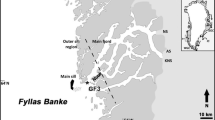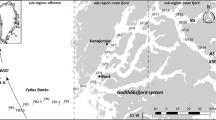Abstract
Plankton abundance and biomass were investigated in five lakes of the McMurdo Dry Valleys, Antarctica: Lakes Bonney, Fryxell, Joyce, Hoare and Miers. Despite plankton communities being dominated by organisms <100 μm in length, there were striking differences between the lakes, including large variations in plankton vertical distribution and differences in total plankton biomass. Bacterial biomass was highest in the anoxic monimolimnia of the meromictic lakes, reaching 191 μg C l−1 in Lake Fryxell. Photosynthetic nanoflagellates dominated phytoplankton in the five lakes studied. Highest chlorophyll a concentrations were recorded at the chemocline of Lake Fryxell (21 μg chl a l−1). Heterotrophic nanoflagellate concentrations were low, ranging from 2 cells ml−1 in Hoare to 237 cells ml−1 in Bonney. By Antarctic standards, ciliates were relatively successful in terms of biomass and diversity in Lakes Fryxell and Hoare. In contrast, Lake Miers possessed extremely low ciliate abundance (<0.04 cells ml−1). On both sampling occasions, copepod nauplii were observed in Lake Joyce. This is the first recording of crustacean zooplankton within the McMurdo Dry Valley Lakes. Because the foodwebs of these lakes are structured by “bottom-up” forces, differences in plankton distributions could be related to the physicochemical characteristics of each lake. The effect of lake evolution (legacy) and present-day climate change on planktonic dynamics is discussed.






Similar content being viewed by others
References
Børsheim KY, Bratbak G (1987) Cell volume to carbon conversion factors for a bacterivorous Monas sp. enriched from seawater. Mar Ecol Prog Ser 36:171–175
Bell EM, Laybourn-Parry J (1999) Annual plankton dynamics in an Antarctic saline lake. Freshwater Biol 41:507–519
Bratbak G, Dundas I (1984) Bacterial dry matter content and biomass estimates. Appl Environ Microbiol 48:755–757
Doran PT, Priscu JC, Lyons WB, Walsh JE, Fountain AG, McKnight DM, Moorhead DL, Virginia RA, Wall DH, Clow GD, Fritsen CH, McKay CP, Parsons AN (2002) Antarctic climate cooling and terrestrial ecosystem response. Nature 415:517–520
Dore JE, Priscu JC (2001) Phytoplankton phosphorous deficiency and alkaline phosphatase activity in the McMurdo Dry Valley lakes, Antarctica. Limnol Oceanogr 46:1331–1346
Finlay BJ, Fenchel T (1996) Ecology: role of ciliates in the natural environment. In: Hausmann and Bradbury (eds) Ciliates: cells as organisms. Fischer, Stuttgart, pp 417–440
Fritsen CH, Priscu JC (1999) Seasonal change in the optical properties of the permanent ice cover on Lake Bonney, Antarctica: consequences for lake productivity and dynamics. Limnol Oceanogr 44:447–454
Green WJ, Friedmann EI (1993) Physical and biogeochemical processes in Antarctic lakes. Antarctic Research Series, vol 59. American Geophysical Union, Washington, DC
Heywood RB (1972) Antarctic limnology: a review. Br Antarct Surv Bull 29:35–65
Howard-Williams C, Schwarz A-M, Hawes I (1998) Optical properties of the McMurdo Dry Valley Lakes, Antarctica. In: Priscu JC (ed) Ecosystem dynamics in a Polar Desert: the McMurdo Dry Valleys, Antarctica. American Geophysical Union, Washington, DC, pp 189–205
Laybourn-Parry J, Bayliss P (1996) Seasonal dynamics of the planktonic community in Lake Druzhby, Princess Elizabeth Land, Eastern Antarctica. Freshwater Biol 35:57–67
Laybourn-Parry J, Marchant HJ, Brown P (1991) The plankton of a large oligotrophic freshwater Antarctic lake. J Plankton Res 13:1137–1149
Laybourn-Parry J, Bayliss P, Ellis-Evans JC (1995) The dynamics of heterotrophic nanoflagellates and bacterioplankton in a large ultra-oligotrophic Antarctic lake. J Plankton Res 17:1835–1850
Laybourn-Parry J, James MR, McKnight DM, Priscu JC, Spaulding SA, Shiel R (1997) The microbial plankton of Lake Fryxell, Southern Victoria Land, Antarctica during the summers of 1992 and 1994. Polar Biol 17:54–61
Laybourn-Parry J, Quayle WC, Henshaw T, Ruddell A, Marchant HJ (2001) Life on the edge: the plankton and chemistry of Beaver Lake, an ultra-oligotrophic epishelf lake, Antarctica. Freshwater Biol 46:1205–1217
Lyons WB, Bartek LR, Mayewski PA, Doran PT (1997) Climate history of the McMurdo Dry Valleys since the last glacial maximum: a synthesis. In: Lyons WB, Howard-Williams C, Hawes I (eds) Ecosystem processes in Antarctic ice-free landscapes. Balkema, Rotterdam, pp 15–22
Lyons WB, Tyler SW, Wharton RA, McKnight DM, Vaughn BH (1998) A lake Holocene desiccation of Lake Hoare and Lake Fryxell, McMurdo Dry Valleys, Antarctica. Antarct Sci 10:247–256
Lyons WB, Fountain A, Doran P, Priscu JC, Neumann K, Welch KA (2000) Importance of landscape position and legacy: the evolution of the lakes in Taylor Valley, Antarctica. Freshwater Biol 43:355–367
Marshall W, Laybourn-Parry J (2002) The balance between photosynthesis and grazing in Antarctic mixotrophic cryptophytes during summer. Freshwater Biol 47:2060–2070
Parker BC, Simmons GMJ, Seaburg KG, Cathey DD, Allnutt FCT (1982) Comparative ecology of plankton communities in seven Antarctic oasis lakes. J Plankton Ecol 4:271–286
Priscu JC (1995) Phytoplankton nutrient deficiency in lakes of the McMurdo Dry Valleys, Antarctica. Freshwater Biol 34:215–227
Priscu JC (1997) The biochemistry of nitrous oxide in permanently ice-covered lakes of the McMurdo Dry Valleys, Antarctica. Global Change Biol 3:301–305
Priscu JC (1998) Ecosystem dynamics in a Polar Desert: the McMurdo Dry Valleys, Antarctica. American Geophysical Union, Washington, DC
Priscu JC, Wolf CF, Takacs CD, Fritsen CH, Laybourn-Parry J, Roberts EC, Lyons B (1999) Organic carbon transformations in the water column of a perennially ice-covered Antarctic lake. BioScience 49:997–1008
Putt M, Stoecker DK (1989) An experimentally determined carbon:volume ratio for marine ‘oligotrichous’ ciliates from estuarine and coastal waters. Limnol Oceanogr 34:1097–1103
Roberts EC, Laybourn-Parry J (1999) Mixotrophic cryptophytes and their predators in the Dry Valley lakes of Antarctica. Freshwater Biol 41:737–749
Roberts EC, Laybourn-Parry J, McKnight DM, Novarino G (2000) Stratification and dynamics of microbial loop communities in Lake Fryxell, Antarctica. Freshwater Biol 44:649–661
Spigel RH, Priscu JC (1998) Physical limnology of the McMurdo Dry Valley lakes. In: Priscu JC (ed) Ecosystem dynamics in a Polar Desert: the McMurdo Dry Valleys, Antarctica. American Geophysical Union, Washington, DC, pp 153–189
Strickland JDH, Parsons TR (1972) A practical handbook of seawater analysis. Fisheries Research Board of Canada
Vincent WF (1988) Microbial ecosystems of Antarctica. Cambridge University Press, Cambridge
Ward BB, Priscu JC (1997) Detection and characterization of denitrifying bacteria from a permanently ice covered Antarctic lake. Hydrobiologia 347:57–68
Acknowledgements
This project was undertaken during the tenure of a Natural Environment Research Council (NERC) studentship held by E.C.R. The Antarctic fieldwork was supported by the Long Term Ecological Research Program on the McMurdo Dry Valleys funded by the National Science Foundation (grant 0PP 9211773). Both sources of funding are gratefully acknowledged. Kathleen Welch, Paula Adkins and Robert Edwards all provided invaluable assistance with fieldwork. We thank the Antarctic Support Association for chemical analysis and Wolfgang Petz for his assistance with ciliate identification.
Author information
Authors and Affiliations
Corresponding author
Rights and permissions
About this article
Cite this article
Roberts, E.C., Priscu, J.C., Wolf, C. et al. The distribution of microplankton in the McMurdo Dry Valley Lakes, Antarctica: response to ecosystem legacy or present-day climatic controls?. Polar Biol 27, 238–249 (2004). https://doi.org/10.1007/s00300-003-0582-0
Received:
Accepted:
Published:
Issue Date:
DOI: https://doi.org/10.1007/s00300-003-0582-0




